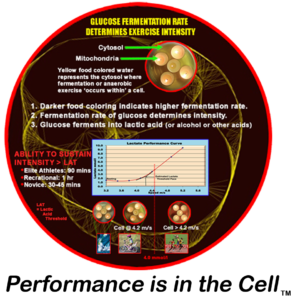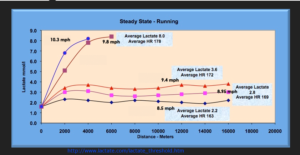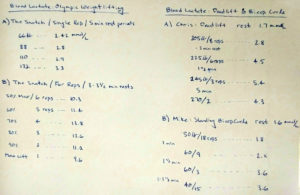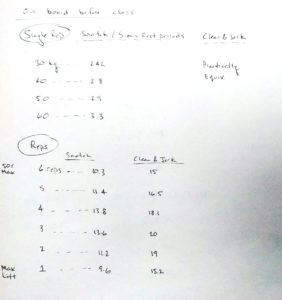The Physical Rules
of Nutrition, Metabolism, and Exercise Science
Week 6. Fitness Lab – Lactate Testing
Meet in the Fitness Lab
Read the two sections below and be prepared to:
- Workout and have your lactate tested.
- Record the measurements in your workbook for week 3.
1. Non-Traditional Lacate Testing: Overview
Rather than perform a lactate test the traditional way – biking or running – we’ll test lactate through a variety of strength and resistance exercises, including classic Olympic weightlifting.
This provides a broader and more complete understanding of how different types of exercise use calories and fuel substrate. Get ready to have some fun testing this out!
The idea to use resistance training for measuring lactate levels occurred to me after I asked myself:
“How high do lactate levels rise during weight lifting?”
I found the following papers and got answers.
Blood Lactate Concentrations at Selected Modes of Olympic Weightlifting
Lactic Acid Buffering: A Critical Reappraisal
According to the second paper – on page 3:
- “Lactate concentration increases from an average value of 1.5 mmol/L to maximal values close to 45 mmol/L for very intense exercise.”
- “Muscle pH decreases from 7.09 to an average minimal value of 6.4
NOTE: A decrease in pH is an increase in acidity.
2. Traditional Lactate Testing
Traditional testing – for endurance athletes: cyclists, rowers, and runners – provides an incomplete view of how different exercises and sports produce acid.
Traditional testing’s purpose is to find a ‘steady state’ race pace or MLSS for an endurance athlete.
Many athletes develop a feel where this pace is. The lactate test just helps hone in on it.
I developed non-traditional testing for fine-tuning your understanding of strength training and matching various exercise regimens with your nutrition intake.
- Many people never develop a sense of scale and a feel for gauging intensity for ALL types of exercise, which is the key for matching their nutritional goals with the training regimen’s purpose. For example:
1. Reps/exhaustion schemes to failure or near failure – used by body builders – are not ideal for building strength or power for most athletes. Reps/exhaustion schemes demand a moderately high to high carb intake.
2. Pure strength training – using heavy weight/low reps – do not require a high carb intake. Pure strength training is ideal for women who want to get strong and not larger, and is best for power athletes who want to maximize strength – but not at the expense of speed. Why?
Because adding mass to the body makes it harder to explode quickly. Imagine wearing a weighted backpack. Extra weight decreases power output during critical moments that a ‘speed-power’ athlete needs it!
Bigger and faster do not necessarily go together, and they surely will not if you consistently train to failure. We’ll look at this closely in week 6: Pure Strength & Speed Training: The Science of Power
- For a concrete example of a ‘speed power’ athlete who has mastered pure strength training and his nutrition intake see the comments by the martial artist – from week 4 , near the bottom of section 2.
Summary
Traditional lactate testing hinders learning a broader and deeper perspective of nutrition and exercise science.
Traditional tests focus on one specific exercise – germane to an athlete’s sport. It ignores the value of seeing rates of glycolysis/lactate production performing common resistance exercises or various athletic competitions that are not running, biking, or rowing.
Blood lactate levels in Chris and Mike: right side
Props
Yeast Packet
Grape Juice
Unpasteurized OJ – Warning Label
Ice Breaker:
What happens if I add this packet to the Grape Juice?
What is produced?
What is the equivalent chemistry in muscles?
What is the equivalent reaction in your colon and latter half of small intestine?
What is the equivalent reaction in your mouth?
How is Kombucha Made?
Drawn on board before class starts:
Additional Reading by Section:
Section 2
Go By Feel, Skip The Lactate Threshold Test
Talking Points / Questions in Class and Afterthoughts
1. Why did I ask Chris to walk around the gym after a set?
2. How is lactate used once circulating in the blood?
3. Why are the lactate readings lower in Chris’s last set with 270lb/2 reps and the last 3 sets of The Snatch (performed for 3, 2 and 1 reps)?
4. When is peak contraction during a bicep curl and what does it mean to:
a. keep tension on the muscle at peak contraction during the lift?
b. maximize the resistance at peak contraction? (opposing force is exactly 180 degrees)
5. Why does limiting the range (failing to fully extend) in a bicep curl build ‘weakness’ in the muscle tendon junction?
6. Why would holding stiff – like ‘at attention’ – increase lactate levels?



